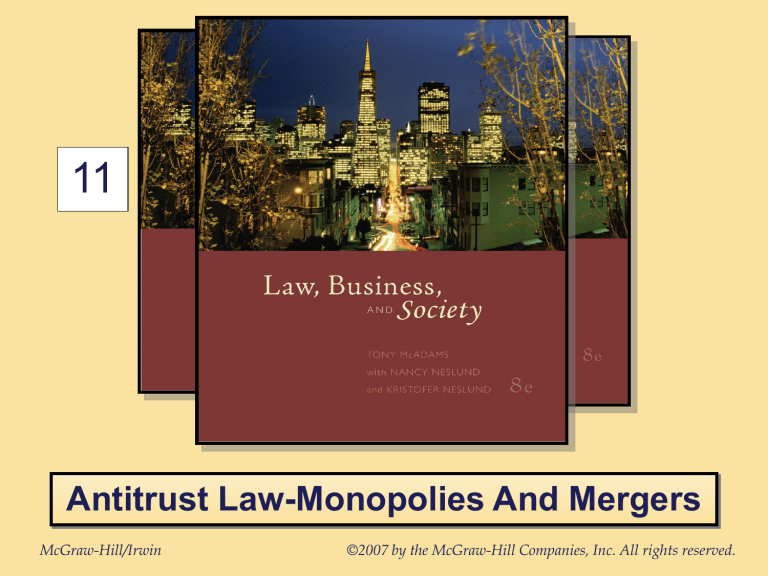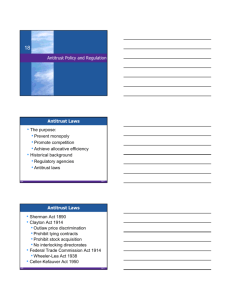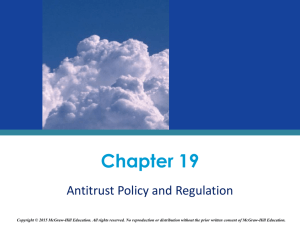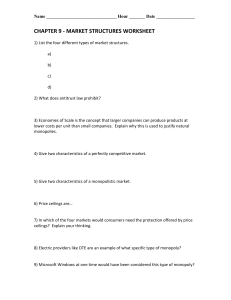Chapter 11

11
Antitrust Law-Monopolies And Mergers
McGraw-Hill/Irwin ©2007 by the McGraw-Hill Companies, Inc. All rights reserved.
Chapter
11
Antitrust Law-Monopolies
And Mergers
Key Points
• Understand the philosophical issues surrounding the existence of monopoly power
• Understand monopoly legislation and legal analysis
• Identify both the potential benefits and harms of mergers
• Understand the evaluation of horizontal and vertical mergers
• Appreciate the international aspects of modern mergers
Microsoft’s Monopoly Woes
In U.S. v. Microsoft , both district and circuit courts held it had violated antitrust law by misusing its monopoly power:
• The district court found Microsoft should be broken into two companies
• The circuit court rejected the break-up remedy and the parties negotiated a settlement (which contained measures designed to stop Microsoft’s exclusionary practices)
The EU found Microsoft guilty of abusing its “near monopoly”; appeals continue
Microsoft has paid billions to settle civil antitrust suits and more suits are pending
Monopoly
Definition : Situation in which one firm holds power to control prices and/or exclude competition in a particular market
General test for illegal monopoly :
• Possession of monopoly power in relevant market and
• Willful acquisition or maintenance of that power, as distinguished from growth or development as a consequence of a superior product, business acumen or historic accident
Monopolization Analysis
Define relevant product market
• Key concept: Cross-elasticity of demand
Define relevant geographic market
• Again using concept of elasticity
Compute defendant’s market power
Asses defendant’s intent
• Usually identified by deliberate actions by monopolist
Raise any available defenses
• Example: Monopoly was “thrust upon” entity
Cross-Elasticity
Fundamental test : Interchangeability, determined by price, use and quality
Cross-elasticity of demand :
• Example : Two products are competitors (and therefore considered in same product market) if an increase in price of one product will cause an increase in sales of the other product
• Reason : Customers see the products as interchangeable and would rather switch products than pay higher price for the first product
Market Power
Rules of Thumb:
• >70% market share—monopoly power may threaten competition
• 50%<market chare<70%--analyze to determine actual market power
• <50%—monopoly power rarely found
Other factors to consider:
• Barriers to entry of new competitors
• Economies of scale
• Strength of competition
• Trends in market
• Pricing patterns
Attempted Monopolization
Illegal under the Sherman Act
Three-part test:
• Defendant has engaged in predatory or anticompetitive conduct
• Defendant had specific intent to monopolize
• Dangerous probability of achieving monopoly power exists
Monopoly Case Examples
Pepsi Co v. Coca-Cola (2d Cir. 2002; 2003):
• Issue was Coca-Cola’s dominance in syrup delivery through independent food distributors (IFDs)
• Held: Delivery of syrup through IFDs not a separate market from delivery through bottlers, therefore
Coca-Cola not found to hold monopoly power
U.S. v. Syufy Enterprises (9 th Cir. 1990):
• Ownership of movie theaters in Las Vegas
• Held: Syufy did not have power to exclude competition or control prices
Mergers —Possible Benefits
• Permits replacement of inefficient management; threat of replacement may discipline managers to be more productive
• May permit stronger competition with previously larger rivals
• May improve credit access
• May produce efficiencies and economies of scale
Mergers —Possible Problems
• Too much power concentrated in too few hands threatening economic well-being and undermining democracy
• Particular merger may trigger a merger movement among industry competitors
• Higher market concentration may lead to higher prices for consumer and lower prices for suppliers
• Innovation may be harmed as smaller companies grow into larger, more bureaucratic structures
• Some companies may become so large that we cannot allow them to fail
Merger Types
Horizontal merger : Involves firms that are in direct competition and occupy the same product and geographic markets
Vertical merger : Involves two or more firms at different levels of the same channel of distribution, such as a manufacturer and a supplier
Conglomerate merger : Involves firms dealing in many, but unrelated products
Hart-Scott-Rodino Antitrust
Improvements Act (HSR)
• Requires reporting and documentation of proposed mergers to FTC if the merger exceeds certain dollar thresholds
• After receiving information, FTC determines whether to do nothing, require some divestitures, or challenge the merger in court
Example : FTC blocked Blockbuster’s proposed merger with Hollywood Entertainment
Horizontal Analysis
FTC/Justice Department concerns:
• Collusion among large competitors
• Unilateral effects in submarkets within a larger product category
Five-step analysis:
1.
Market defined as smallest product and geographic market in which a hypothetical monopolist could raise prices a “small but significant and nontransitory” amount (usually set at 5%)
2.
Measurement of market concentration using HHI
3.
Identification of likely anticompetitive effects
4.
Likelihood of future entrants into market
5. Appraisal of efficiencies and other possible defenses
Market Concentration
Generally measured with the Herfindahl-Hirschman Index
(HHI)
HHI = (market share of firm 1) 2 x (market share of firm 2) 2
HHI measure before and after proposed merger:
• If HHI after merger is 1800 or larger AND change from before to after is above 50, merger considered potentially threatening
• Post-merger 1000 < HHI < 1800 AND change above
100, threat depends on analysis of other factors
• Post merger HHI < 1000, ordinarily not challenged
Horizontal Merger
Example : FTC v. Staples, Inc. and Office Depot, Inc.
(D.C. D.C. 1997)
Relevant geographic market :
42 specific metropolitan areas
Relevant product market :
Sale of consumable office supplies through office supply superstores
Market concentration :
Average HHI increase = 2715
Vertical Analysis
Definition : An alliance between supplier and purchaser
Primary concern : Market foreclosure —the merger may deny a source of supply to a purchaser or an outlet for sale to a seller
Other concerns :
• Raising rivals’ costs
• Facilitating collusion
• Raising barriers to entry
• Increasing access to competitively sensitive information
• Encouraging discrimination in access to products and services
• Reducing incentives for innovation
Antitrust and Global
Competitiveness
• Many nations have antitrust laws
• Some mergers may require review by dozens of nations with differing timelines, procedures and document requirements
• An International Competition Network is working to encourage greater convergence in merger policies and procedures






